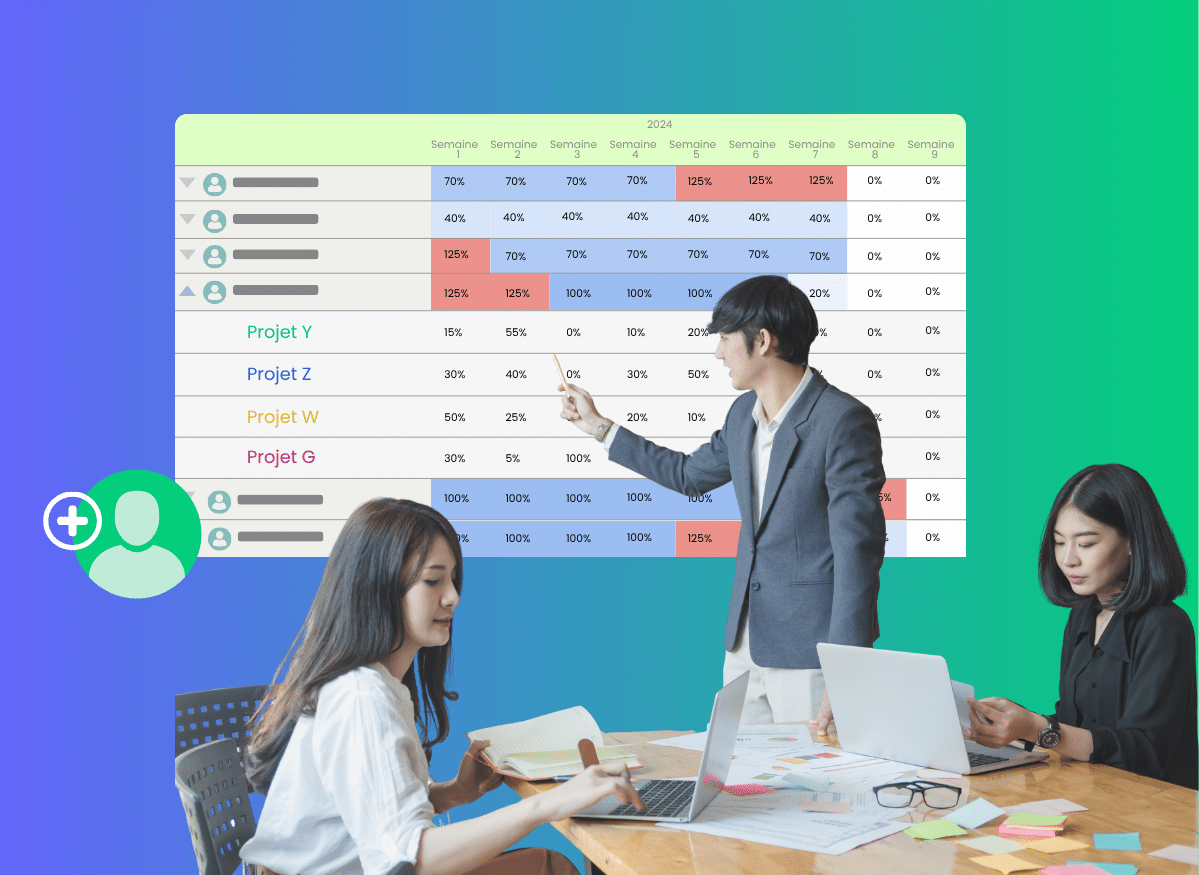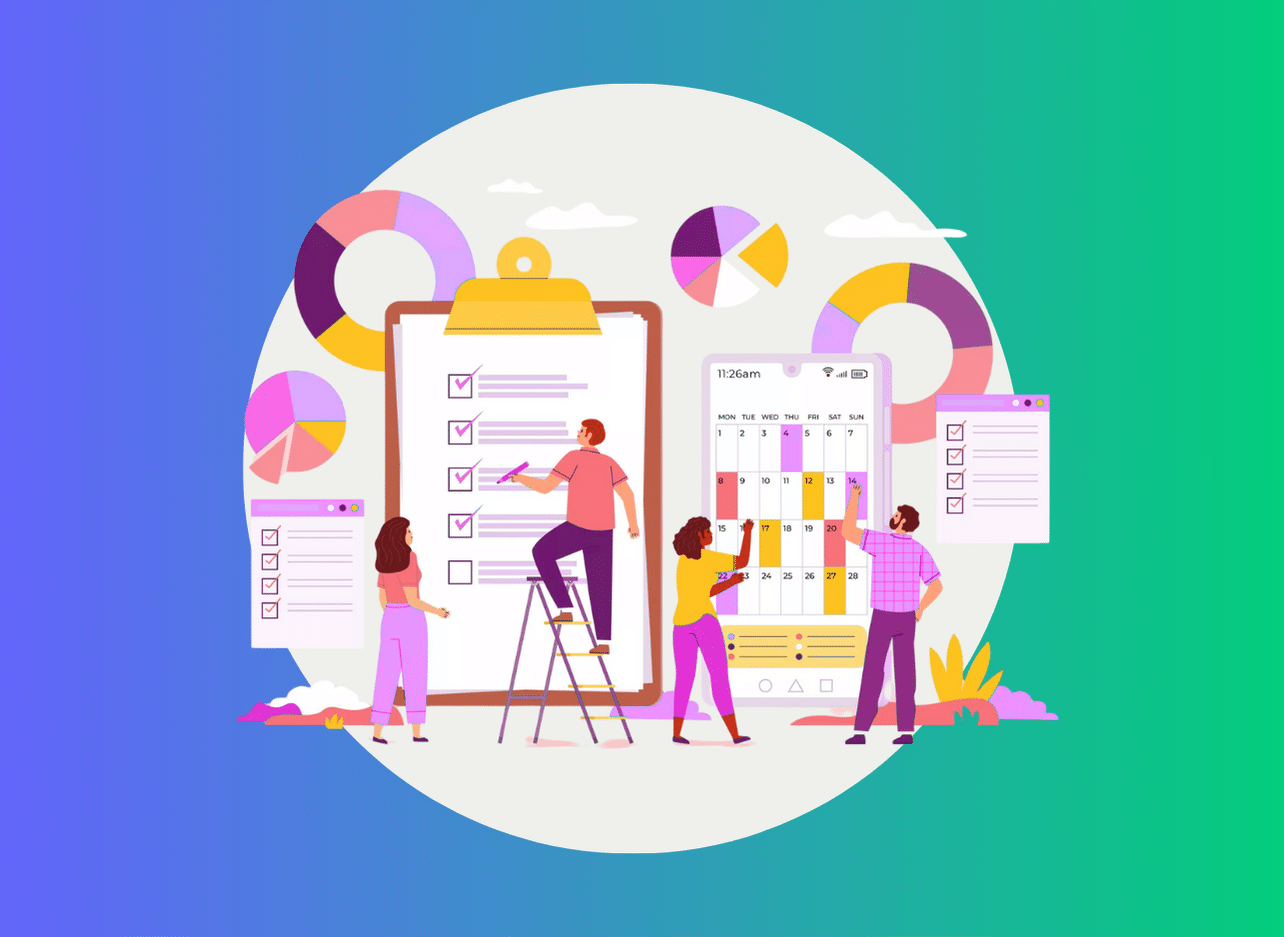The Different Dimensions Of Project Planning

Before delivering the first deliverable to a client, or even before the first project meeting, this essential question arises: how do I organize the work to achieve my set goal on time and without going over budget? This is where project planning comes in.
It allows you to plan each step, define a clear plan, a logical scheduling of tasks and a precise backschedule. This programming ensures the consistency of schedules and facilitates the simulation of different scenarios according to resource or time constraints.
On the ground, the exercise is much more complex. On average, 44% of projects fail due to a lack of planning (source: Zipdo) and only 48% deliver on their promises in terms of deadlines , budgets, and goals (source: The Business Dive).
Faced with shifting perimeters, strained resources and constant unforeseen events, project planning can no longer be satisfied with a simple fixed schedule. Management must be done in real time, while being based on a reliable forecast, which implies continuous cost evaluation and precise budgeting in the service of a project strategy. The question is: how?
In this article, we explore the different dimensions of project planning and how to articulate them in a digital transformation framework. Whether you are a project manager, mission director or PMO, you will discover here how to structure your missions according to the 4 fundamental dimensions (scope, time, resources, quality), but also how to integrate risks, governance and budget for truly predictive management.
Why is project planning more than ever a strategic issue?
Staying on budget, meeting deadlines, and mobilizing the right resources at the right time—this is the balance every project manager seeks to maintain. In project management, this search for balance is based on rigorous planning, regular monitoring and effective use of management tools. Good management must make it possible to constantly adjust the schedule and the workload to guarantee profitability and customer satisfaction.
This requires more than just organizing tasks. It must participate in securing overall performance: profitability, customer satisfaction and ability to deliver despite the unexpected.
Increasing complexity
Today's service companies have to juggle multiple projects, hybrid teams, and customers with ever-changing expectations. Each mission depends on a set of interdependent constraints:
- the availability of resources;
- often tight contractual deadlines;
- financial margins that are difficult to preserve;
- Technical or regulatory dependencies that block or delay subsequent tasks.
Project managers thus evolve in an ecosystem in constant tension, in which a simple error in estimation can upset the balance they have patiently put in place. When a key employee becomes unavailable, the entire portfolio must be readjusted. When a customer changes their need mid-term, the budget and margins must be recalculated immediately.
Faced with this increase in unforeseen events, traditional project management methods are reaching their limits. Scattered spreadsheets and frozen Gantt charts are no longer enough to absorb changes in real time. Organizations need to rely on modern collaborative tools and project management software (sometimes integrated with an ERP) that can plan, deploy, and develop complex engagements.
From planning to steering: the paradigm shift
Before, projects were based on a fixed provisional schedule, which did not change once the mission was launched. An approach that only works in a stable setting, when you don't experience any major upheaval. Most of the time, a provisional schedule that does not evolve is insufficient, because priorities change quickly, teams are more flexible to respond to more volatile customer requests, all within ever more compressed deadlines.
The challenge is no longer just to plan, but also to manage continuously. This management is now based on collaborative tools and dynamic dashboards, capable of unifying portfolio management, project monitoring and translating project programming into KPIs. Thanks to a clear mapping of objectives and risks, each mission can be planned according to forecast scenarios. The role of the project manager is transformed: he becomes a real analyst of the mission's operational and financial data.
This paradigm shift is reflected in 3 major developments, both strategic and operational:
- From point vision to continuous visibility: planning is no longer based on a fixed and fixed document, but on a real living and moving system. Inside, the information is updated in real time to allow decision-makers to act before load, budget or deadline drifts occur.
- From compliance to performance management: success is no longer measured solely by adherence to the schedule, but by the ability to deliver measurable value.
- From individual control to integrated collaboration: success is no longer the responsibility of the project manager alone, but of the entire team. Each member of the team feeds the KPIs in real time by entering the time spent, and monitoring the progress of deliverables and the load.
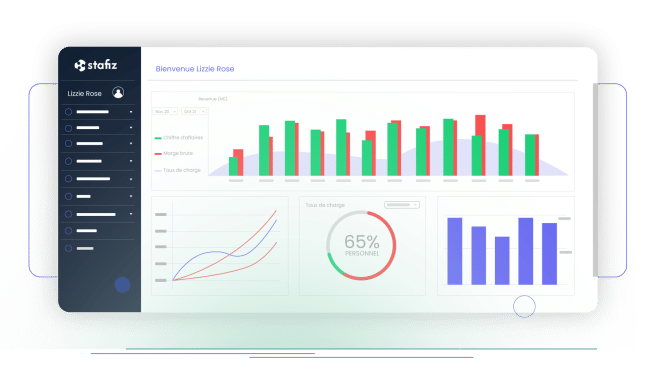
Thanks to its dynamic dashboards, Stafiz automatically links workload plans, time entries and margins, to transform planning into a real real-time management tool.
What are the 4 main dimensions of project planning?
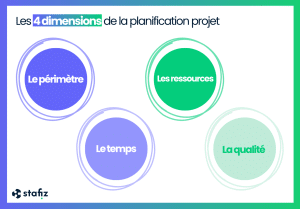
The scope dimension
The scope defines what should be delivered (and what should not be delivered). It supervises:
- the expected deliverables;
- the objectives to be achieved;
- technical and functional requirements;
- the limits of the field of action.
Be careful: a vague perimeter inevitably leads to abuses: unplanned additional tasks, delays, unbalanced budgets, etc.
💡 The best practice in project planning: use a WBS (Work Breakdown Structure) to break down the mission into clear deliverables and then into measurable tasks. This structure facilitates monitoring and serves as a common reference for all stakeholders.
The time dimension
The deadline dimension in project planning is the backbone of the mission. Defining milestones, ordering tasks and identifying the critical path allows us to understand where the room for manoeuvre lies, and the risks of slippage.
It's not just about setting dates in a reverse schedule, but about modeling dependencies and identifying the critical path in the project schedule. What tasks condition others? Which ones can take place in parallel? These elements impact the progress, the monitoring of tasks and progress, the remaining load and invoicing.
The resource dimension
The resources dimension in project planning answers 3 questions: who does what, when, and what is their responsibility? Successful planning must avoid both underloading (loss of productivity) and overload (risk of burnout and loss of quality).
Resource management also involves selecting the right profiles, taking into account absences (billable utilization rate) and adjusting priorities as available.
The quality dimension
This dimension corresponds to your criteria for the success of the mission and the validation of the deliverables: compliance with expectations, customer satisfaction, etc. Quality is planned as much as it is controlled: by integrating intermediate validation points, measurable acceptance criteria and project reviews at each milestone.
How do these dimensions interact with each other?
These four dimensions never work in isolation. Any decision taken on one will impact the others:
- a change in scope modifies the costs and deadlines;
- a delay on a critical task impacts resources and margins;
- overloading can degrade quality, etc.
At the basis of piloting is the golden trio: scope, time, resources. Visualizing their interdependencies, both in real time and in forecasting, is essential to understand the effects of a decision before it has its consequences. Should priorities be reviewed? Adjust the load? Redefining deliverables?
These trade-offs only make sense with a reliable overview.
Quality is both a consequence and a constraint linked to the other three dimensions. For example, deadlines that are too short require more resources to be found or the scope to be reduced. Similarly, too high requirements or insufficient resources can lead to delays.
Hence the importance of having an integrated vision to make informed decisions. Without all the data, it is impossible to anticipate in the event of the unexpected.
At the portfolio level, this interconnection makes it possible to prioritize missions according to their margins, deadlines and risks. The role of the project manager then expands to that of collective performance pilot.
In Stafiz, these four dimensions are interconnected and visible in the same dashboard: workload plan, progress, costs and performance. Each schedule, resource, or deliverable update automatically adjusts other parameters to allow the project manager to instantly measure the impact of their decisions and take action before drifts take hold.
Other dimensions to integrate for modern planning
The four dimensions mentioned above (scope, time, resources and quality) are no longer sufficient to control the complexity of current projects. Today's companies have to deal with uncertainty, financial requirements, multi-level collaboration and fine-grained capacity management. Managing several missions at the same time requires enhanced coordination, often supported by project management software integrated into an ERP. These tools make it possible to consolidate the load, the budget and the margins in a collaborative management environment.
The risks and uncertainties dimension
No project escapes the unexpected, and these factors can affect budget, quality, or profitability. Extended deadlines, absence of a key employee, change of priorities on the customer side: how can you anticipate these risks before they block your progress?
Risk management must be integrated from the planning phase. Anticipating these hazards helps prevent them from turning into crises.
The most mature companies build a risk map: they identify potential threats, assess their likelihood and measure their impact on planned deadlines and margins. The post-project analysis then makes it possible to compare the forecast with the actual and to improve future practices. This approach allows you to adjust expenses, resources and objectives in advance.
InStafiz, progress and load indicators make it possible to quickly identify areas at risk (overload, drift, undercapacity) and to anticipate the impact on margins and deadlines.
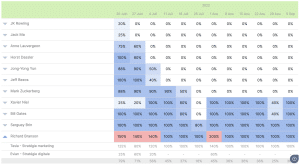
Stafiz shows overloaded profiles at a glance (overloaded profiles appear in red and availability in blue). During the project, you will be warned before the drift takes place.
The governance dimension
Effective planning also relies on clear and shared governance, i.e. maintaining constant alignment between all stakeholders: management, managers, teams, customers and partners. Who makes the decision? Who validates the deliverables? Which person intervenes at what time?
Without a clear framework, decision-making is delayed, and your planning becomes unreliable. You must be able to effectively communicate priorities and progress at each stage of its project lifecycle.
The budgetary dimension
The budget must be at the heart of the management of the project. Linking load forecasts to actual costs, daily rates and margin targets allows profitability to be continuously evaluated.
This link between planning and finance is often absent from traditional tools, forcing teams to juggle between Excel and accounting software.
Capacity and resource planning
Planning does not stop at the management of current assignments, but encompasses the future burden of your entire IT Services to ensure business continuity. With allocation management and margin forecasting, Stafiz connects planning with financial management.
This long-term visibility on the load helps to identify future imbalances : occasional overload, under-use of certain teams, or lack of key profiles in the coming months. It thus offers a strategic lever to adjust priorities, plan recruitment or use subcontracting before a bottleneck forms.
The resource planning allows for better management, but also better management of the company. This approach turns planning into a real tool for growth.
What are the different project planning steps?
How do you plan a project effectively? Six management steps are essential, each contributing to the control of costs, workload and the quality of deliverables:
- Define goals, budget, and deliverables: You explain why the project exists, its goals, what it needs to deliver, and within what time and budget limits. This step is usually accompanied by a framework note for all stakeholders.
- Identify tasks and their dependencies: you list all tasks, subtasks, milestones, their dependencies and plan their scheduling. This analysis will make it possible to anticipate the risks of delays and to build a realistic schedule.
- Evaluate resources and deadlines: you estimate the workload needed for each task and match it to the right profiles. This step determines the overall duration of the mission and helps to adjust priorities based on capacity or availability constraints.
- Build the schedule: you organize the tasks in time according to their logical order and estimated duration.
- Allocate resources and balance loads: You assign people to different jobs, taking into account their skills, current workload and leave. The objective: to balance the work without creating overload.
- Monitor, adjust and replan according to the reality: you measure progress, compare the forecast to the actual and replan as soon as a discrepancy appears.
In practice, the project manager can also rely on monitoring tools such as Trello, Ms Project or Kanban, depending on the size and complexity of the project. These solutions make it easy to visualize project phases, detect deviations, and implement necessary adjustments.
How is project planning evolving in a context of transformation?
Project planning is affected by organizational change. Between digitalization, the emergence of hybrid working methods and remote work, it can no longer be limited to simple task monitoring: it must interface with HR, financial and operational tools to offer you a complete view of performance. This evolution also leads to a more agile approach. Companies are adopting shorter cycles, regular task reviews, and flexible resource allocation to better adjust to unpredictable events.
Another major challenge lies in multi-project management. Managers must balance multiple priorities in their portfolios, balance loads, manage dependencies, and anticipate resource needs. This management requires collaborative tools that can consolidate data in real time and allow for seamless dissemination of information between teams.
Today's companies need integrated planning solutions that can combine strategic vision and operational management. Modern SaaS tools are gradually replacing heavy solutions such as ERP or spreadsheets, promoting collaborative work and the adoption of agile methods. A project management software such as Stafiz is fully in line with this modern approach, as they bring together in a single environment:
- global and individual project management ;
- capacity planning and fine-grained resource management;
- a dynamic and adjustable calendar;
- automated alerts to anticipate load or budget drifts;
- and proactive risk management.
Planning software covers all the key dimensions of project planning: setting delivery and load targets, and tracking and managing time.
Thanks to this unified vision, Stafiz helps organizations transform their project planning into a real lever for management and anticipation, in the service of a more agile and efficient company.
Project planning is the foundation of performance management. By combining best management practices and adapted planning software, project managers have a unified vision of monitoring and implementation. The result: better cost control, greater responsiveness to hazards and a real success of projects in the long term.
Questions:
Project planning is the initial and structuring step that consists of defining the scope, objectives, deliverables, resources, budget and schedule before the project is launched. Project management, on the other hand, is the continuous process of execution and control. In summary, planning is the what and how on paper, while management is active implementation.
Successful planning is based on four fundamental elements:
- A clear definition of the scope and SMART objectives.
- A detailed Work Breakdown Structure (WBS), breaking down deliverables into manageable tasks.
- An accurate estimate of resources (time, budget, personnel).
- Establishing a realistic timeline that identifies critical dependencies and milestones.
Risk integration is already done in the planning phase. Potential risks (delays, additional costs, resource problems) must be identified and analysed and their impact assessed. Second, define mitigation plans to reduce their likelihood and effect. Finally, plan a budget and time buffers to absorb unforeseen events.
Stakeholder involvement relies on transparent, two-way communication. Key stakeholders (customers, teams, management) must be consulted to gather their expectations and expertise when defining the scope and estimating tasks. Holding inclusive planning workshops and getting their formal approval of the final plan ensures their commitment and reduces resistance to future changes.
